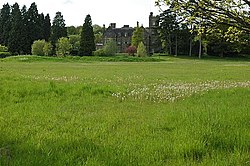Blaisdon Hall
| Blaisdon Hall | |
| Gloucestershire | |
|---|---|

| |
| Location | |
| Grid reference: | SO69821697 |
| Location: | 51°51’2"N, 2°26’22"W |
| History | |
| Built 1876 | |
| For: | William Crawshay |
| Country house | |
| Neo-Jacobean | |
| Information | |
| Website: | www.blaisdonhall.co.uk |
Blaisdon Hall is a country house in Gloucestershire, at Blaisdon at the edge of the Severn Valley, ten miles south-west of the county town, Gloucestershire. The house was built in 1876 by William Crawshay, for who was reputedly the most successful ironmaster in the Forest of Dean.
The house today is a Grade II* listed building.[1]
History
The hall was built in 1876 by William Crawshay for his son, Edwin.[2] It was extended in 1907 by P. Stubbs.[1]
The Crawshay family owned the house until in 1935 it was sold to the Salesion Society, who established an agricultural school for training underprivileged boys.[2] Later it reverted to private ownership.
The house
Blaisdon Hall is built in an elegant Jacobean style, and notwithstanding change of use, it retains its original character. It has original stained glass windows, oak panelling and coffered ceilings.
The house is stone-built, on two storeys with slate roofs. At the rear are two projecting wings with a courtyard between them. On the right of the front is a four-storey tower with a porte-cochere.[1]
Nature conservation
Within the estate is a small are, just 0.17 acres, defined as a 'biological Site of Special Scientific Interest'.[3]
The site supports a breeding roost of Lesser horseshoe bats which consists of one fifth of the known Gloucestershire breeding population, and has been deemed by Natural England to be of national importance. The site comprises part of the roof void, roof tiles, roof timbers, the flanking walls of the Hall and the nearby workshop. Pipistrelle bats and Brown long-eared bats also are recorded using the Hall.[3] The Wye Valley and Forest of Dean are one of the main locations for Lesser horseshoe bats because of the deciduous woodlands and, sheltered valleys, which provide a good feeding area, and the underground systems which provide roosting and breeding sites.[3]
Outside links
| ("Wikimedia Commons" has material about Blaisdon Hall) |
References
- ↑ 1.0 1.1 1.2 National Heritage List 1121880: Blaisdon Hall
- ↑ 2.0 2.1 History: Blaisdon Hall
- ↑ 3.0 3.1 3.2 SSSI listing and designation for Blaisdon Hall
